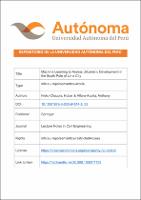Machine Learning to Assess Urbanistic Development in the South Pole of Lima City

View/
Author(s)
Nieto-Chaupis, Huber
Alfaro-Acuña, Anthony
Date
2022-01-01Metadata
Show full item recordPublisher
Springer
Journal
Lecture Notes in Civil Engineering
Additional Links
https://www.scopus.com/inward/record.uri?eid=2-s2.0-85125230044&doi=10.1007%2f978-3-030-94514-5_33&partnerID=40&md5Abstract
We employ Machine Learning through the Mitchell’s criteria to carry out an assessment on the potential spatial configurations at the south pole of Lima city, at Perú. Based at both qualitative and quantitative facts, an model has been proposed that targets to measure the success of spatial expansion of districts based at distances and number of habitants. In this manner Machine Learning appears as a robust tool with capabilities to anticipate the possible achievements as well as issues along the time the city is under spatial growth. The efficiency of sustained growth is measured in terms of success probability. Therefore, we can claim that the ongoing growth of Villa el Salvador engages to some extent the philosophy of Mitchell’s criteria.
Type
info:eu-repo/semantics/article
Rights
info:eu-repo/semantics/restrictedAccess
Language
eng
Collections
- Ingeniería de Sistemas [332]

